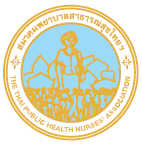เกี่ยวกับวารสาร
วารสารมีวัตถุประสงค์เพื่อเผยแพร่ผลงานการศึกษาค้นคว้าและผลงานการวิจัยที่เกี่ยวข้องด้านการ พยาบาลสาธารณสุข การสาธารณสุข และการพยาบาล และเพื่อเป็นสื่อกลางในการแลกเปลี่ยนความรู้ และความคิดทางวิชาการ เสริมสร้างสัมพันธภาพระหว่างผู้ที่อยู่ในกลุ่มวิชาชีพ
ISSN: 3057-014x (Print)
ISSN: 3057-0158 (Online)
ฉบับปัจจุบัน
ฉบับเต็ม
บทความวิจัย
ปัจจุบันวารสารพยาบาลสาธารณสุขอยู่ในระดับ วารสารกลุ่มที่ 2 ผ่านการรับรองคุณภาพของ TCI (Thai Citation Index) วารสารที่ใช้ระบบ Double-blind peer review โดยมีผู้เชี่ยวชาญ 3 ท่านต่อเรื่องเป็นผู้ตรวจประเมินและให้ข้อเสนอแนะ และได้เตรียมพัฒนา กระบวนการและผลผลิตของงาน ให้ได้รับการคัดเลือกเข้าสู่ฐานข้อมูล ACI (ASEAN Citation Index) ต่อไป
วารสารพยาบาลสาธารณสุขได้รับการยอมรับจาก โครงการปริญญาเอกกาญจนาภิเษก (คปก) ให้สามารถตีพิมพ์ต้นฉบับดุษฎีนิพนธ์ สำหรับนักศึกษาปริญญาเอกส่งมาตีพิมพ์ได้ เพื่อใช้เป็นส่วนหนึ่งในการขอจบการศึกษา หลังจากตีพิมพ์ผลงานในวารสารนานาชาติแล้ว 1 ฉบับ นั่นคือเหตุผลว่าเราต้องปรับปรุงคุณภาพของวารสารอย่างต่อเนื่อง
ทั้งนี้ กองบรรณาธิการขอสงวนสิทธิ์ ในการตรวจทานและแก้ไขต้นฉบับ และพิจารณาเรื่องที่จัดพิมพ์
เพื่อความสะดวกแก่การพิจารณาจึงขอแนะนำการเขียนและเตรียมต้นฉบับ ดังนี้
ประเภทของเรื่องที่จะตีพิมพ์
- บทความทางวิชาการ/วิจัยเกี่ยวกับการพยาบาล การพยาบาลสาธารณสุข หรือพยาบาลอนามัยชุมชน การสาธารณสุข
- รายงานการวิจัยทางการพยาบาลสาธารณสุข การสาธารณสุข และการพยาบาล ผลงานวิชาการด้านการเรียนการสอน การเรียนรู้ การพัฒนานโยบายสาธารณะ กรณีศึกษา ผลงานวิชาการรับใช้สังคม โดยมีรูปแบบของบทความตามที่กำหนดในแต่ละประเภท ตามคุณภาพของผลงาน ในประกาศ ก.พ.อ.
- บทความปริทัศน์รวบรวม หรือเรียบเรียงจากเอกสารหรือหนังสือต่างๆ ตลอดจนการจัดประชุมวิชาการระดับชาติ และนานาชาติ เพื่อเผยแพร่และฟื้นฟู งานด้านวิชาการ
- บทความ ข้อคิดเห็น หรือข้อเสนอแนะที่เป็นประโยชน์ในด้านวิชาการ เรื่องแปล ข่าววิชาการย่อความ จากงานวิจัยค้นคว้า หรือสิ่งที่น่าสนใจ
- ข้อคิดเห็น ความเคลื่อนไหวในวงการสาธารณสุข
เรื่องที่จะตีพิมพ์จะต้องเป็นเรื่องที่ ไม่เคยตีพิมพ์ที่ใดมาก่อน หรือ ไม่อยู่ในระหว่างส่งไปตีพิมพ์ในวารสารฉบับอื่น บทวิจัยหรือบทความวิชาการที่ได้รับตีพิมพ์ กองบรรณาธิการจะส่งวารสารที่ตีพิมพ์บทวิจัยหรือบทความนั้น ให้สมาชิกวารสารที่เป็นสถาบันและบุคคล สำหรับผู้แต่ง สามารถ Download ได้ที่ https://he01.tci-thaijo.org/index.php/phn
รูปแบบของการเขียนและการเตรียมต้นฉบับบทความและงานวิจัย
ต้นฉบับพิมพ์ด้วยอักษร TH Sarabun PSK ขนาด 14 พิมพ์หน้าเดียว โดยใช้กระดาษพิมพ์ ขนาดกระดาษ A4 จำนวนไม่เกิน 12 หน้า (รวมชื่อเรื่อง, บทคัดย่อไทย/ อังกฤษ, เอกสารอ้างอิง) โดยให้มีหัวข้อของบทความและงานวิจัยให้ครบถ้วน ดังนี้
- ชื่อเรื่อง ทั้งภาษาไทยและภาษาอังกฤษ
- ชื่อ และนามสกุล ทั้งภาษาไทยและภาษาอังกฤษ ของผู้แต่งอยู่ใต้ชื่อเรื่องโดยเยื้องไปทางขวามือ ส่วนตำแหน่งในปัจจุบันและสถานที่ทำงานของผู้เขียนตามลำดับ ทั้งภาษาไทยและภาษาอังกฤษ และระบุผู้รับผิดชอบหลัก ให้พิมพ์ไว้เป็นเชิงอรรถ
- บทคัดย่อภาษาไทยและภาษาอังกฤษ โดยเขียนลักษณะเรียงลำดับเป็นความเรียงให้สอดคล้องกัน ภาษาไทยความยาวไม่เกิน 1 หน้า (ขนาด A4) รวมชื่อเรื่องทั้งภาษาไทยไม่เกิน 250 คำ และภาษาอังกฤษไม่เกิน 200 คำ แล้ว ประกอบด้วย 3 ส่วน ดังนี้
ส่วนที่ 1 ความสำคัญของปัญหา วัตถุประสงค์การวิจัย กรอบแนวคิด/ทฤษฎีที่นำมาใช้ชนิดของการวิจัย สถานที่ศึกษาประชากรและลักษณะกลุ่มตัวอย่าง จำนวนและวิธีการได้มาของกลุ่มตัวอย่าง เครื่องมือวิจัย และการตรวจสอบคุณภาพ การผ่านการตรวจสอบทางจริยธรรมของโครงการ สรุปวิธีการเก็บรวบรวมข้อมูล และการพิทักษ์สิทธิ์กลุ่ม ตัวอย่างในการดำเนินการวิจัย และการวิเคราะห์ข้อมูล
ส่วนที่ 2 รายงานผลการวิจัยตามวัตถุประสงค์ กะทัดรัด ชัดเจนสอดคล้องกับผลและข้อเสนอแนะที่สอดคล้องกับผลการวิจัยสำคัญ และการนำผลการวิจัยไปใช้
ส่วนที่ 3 ให้เขียน “คำสำคัญ” (Key word) ของงานวิจัยครั้งนี้ทั้งภาษาไทยและภาษาอังกฤษ 3-5 คำ
- เนื้อหาของการวิจัย ประกอบด้วยหัวข้อต่อไปนี้ คือ
- ความเป็นมาและความสำคัญของปัญหาในการวิจัย
- วัตถุประสงค์การวิจัยและคำถาม/สมมุติฐานการวิจัย
- กรอบแนวคิดที่ใช้ในการวิจัย
- วิธีการดำเนินการวิจัย เขียนเป็นความเรียง แบ่งเป็น 3 ตอน ดังนี้
ตอนที่ 1 รูปแบบของการวิจัย วัตถุประสงค์การวิจัย ประชากรและลักษณะกลุ่มตัวอย่าง จำนวนและวิธีการได้มาของกลุ่มตัวอย่าง
ตอนที่ 2 เครื่องมือวิจัยและการตรวจสอบคุณภาพ เครื่องมือที่ใช้ในการวิจัยมีกี่ส่วนอะไรบ้าง สรุปลักษณะเครื่องมือแต่ละส่วนและเกณฑ์การแปลผล และการตรวจสอบคุณภาพทั้งความตรง (Validity) และความเชื่อมั่น (Reliability) ค่าดัชนีความตรงตามเนื้อหา (ถ้ามี) และการหาค่าความเชื่อมั่น ทำกับใคร จำนวนเท่าใด ใช้สูตรอะไรและได้ค่าเท่าใด
ตอนที่ 3 การเก็บข้อมูลทำอย่างไร จำนวนเท่าใด ได้กลับมาเท่าใด คิดเป็นร้อยละเท่าใด การวิเคราะห์ข้อมูลใช้โปรแกรมและสถิติอะไร
- ผลการวิจัย (ตาราง หรือแผนภูมิ หรือกราฟ รายงานเป็นภาษาอังกฤษ) และการอภิปรายผล สรุปจุดอ่อนและจุดแข็งของงานวิจัย และสรุป
งานวิจัยนี้มีจุดแข็ง ได้แก่ การออกแบบการทดลองที่รัดกุมและมีแผนการดำเนินการทดลองที่กระชับสอดคล้องกับภาระหน้าที่ของวัยทำงานที่เข้าร่วมโปรแกรม นอกจากนี้ การออกแบบเนื้อหาของโปรแกรมยังมีความสอดคล้องกับผลการทบทวนวรรณกรรมที่เกี่ยวข้องและมีทฤษฎีรองรับที่ชัดเจน ชุมชนที่ทำการทดลองเห็นความสำคัญของการลดการสัมผัสสารเคมี อุปกรณ์ป้องกันการสัมผัสสารเคมีในระหว่างการทดลอง เช่น หน้ากากป้องกันสารเคมีที่ได้มาตรฐานได้รับการสนับสนุนเป็นอย่างดี อย่างไรก็ตาม
งานวิจัยนี้มีจุดอ่อนเนื่องจากระยะเวลาการศึกษาวิจัยมีจำกัด ส่งผลให้ขาดการทดสอบตัวชี้วัดทางชีวภาพ (Biomarker test) เพื่อบอกระดับของการสัมผัสสารเคมีได้จริง และการวิจัยนี้ระดับวัดพฤติกรรมตามการรับรู้ของกลุ่มตัวอย่างโดยใช้แบบสอบถามเท่านั้น ผู้วิจัยไม่ได้วัดหรือสังเกตพฤติกรรมจริง (Actual behaviors) ในการป้องกันตนเองจากสารเคมีกำจัดศัตรูพืชของชาวนากลุ่มตัวอย่างเพื่อมาใช้ในการวิเคราะห์ผล
สรุป โปรแกรมลดการสัมผัสสารเคมีกำจัดศัตรูพืช มีประสิทธิผลต่อเกษตรกรชาวนากลุ่มทดลอง โดยภายหลังการเข้าร่วมโปรแกรม และระยะติดตามผล 1 เดือน เกษตรกรชาวนามีคะแนนความรู้ การรับรู้ความสามารถของตนเอง ความคาดหวังในผลดี และพฤติกรรมการป้องกันตนเองจากสารเคมีกำจัดศัตรูพืชเพิ่มขึ้นมากกว่าก่อนการทดลองและมากกว่ากลุ่มควบคุมทั้งภายหลังการทดลองและระยะติดตามผล
- ตารางนำเสนอการวิเคราะห์ข้อมูล ไม่เกิน 3 ตาราง และเป็นภาษาอังกฤษ
- ข้อเสนอแนะในการนำผลการวิจัยไปใช้ ที่สอดคล้องกับข้อค้นพบที่สำคัญ
- ข้อเสนอแนะในการทำวิจัยครั้งต่อไป เพื่อขยายหรือตรวจสอบองค์ความรู้
- ระบุการได้รับทุน ในกิตติกรรมประกาศ ถ้าไม่ได้รับระบุว่าไม่ได้รับ
เอกสารอ้างอิง เป็น ภาษาอังกฤษ ใน ระบบ Vancouver style ตรวจสอบความถูกต้องครบถ้วนของการอ้างอิง ภายในเนื้อหาและท้ายบท ถ้าสามารถใช้ End Note ได้จะดี
การจัดเตรียมต้นฉบับ ต้นฉบับควรจะมีขอบ 1 นิ้ว ที่ด้านใดด้านหนึ่งของกระดาษ A4 สำเนาปัจจุบันของวารสารจะแสดงรูปแบบและสไตล์ที่ถูกต้องที่ https://he01.tci-thaijo.org/index.php/phn หรือสามารถสอบถามข้อมูลเพิ่มเติมได้ที่ E-mail : journal.thaiphn@gmail.com
Tel: 095 7013182
อักษรภาษาไทย ใช้แบบอักษร (Fonts) TH Sarabun PSK ระยะห่างระหว่างบรรทัด 1 (Double line space) ชื่อเรื่องใช้ขนาดตัวอักษร 17 และตัวหนา ชื่อนามสกุลของผู้เขียนหรือผู้ร่วมงานวิจัย ใช้ขนาดตัวอักษร 15 และเป็นตัวหนา ความเกี่ยวพัน ความรับผิดชอบงานวิจัยนี้ และชื่อสถานที่ทำงานในปัจจุบัน ใช้ขนาดตัวอักษร 12 เป็นตัวปกติ เนื้อหาที่ใช้ขนาดตัวอักษร 14 และตัวปกติ
อักษรภาษาอังกฤษ Abstract, Table และ Reference ใช้แบบอักษร (Fonts) TH Sarabun PSK ระยะห่างระหว่างบรรทัด 1 (Double line space) ชื่อเรื่องใช้ขนาดตัวอักษร 17 และเป็นตัวหนา ชื่อนามสกุลของผู้เขียนหรือผู้ร่วมงานวิจัย ใช้ขนาดตัวอักษร 15 และเป็นตัวหนา ความเกี่ยวพัน ความรับผิดชอบงานวิจัยนี้ และชื่อสถานที่ทำงานในปัจจุบัน ใช้ขนาดตัวอักษร 12 และเป็นตัวปกติ เนื้อหาที่ใช้ ขนาดตัวอักษร 14 และปกติ (ควรติดเลขหน้าเส้นบรรทัดทุกหน้า)
การตีพิมพ์บทความวิชาการหรือวิจัยจะได้รับการประเมินคุณภาพอย่างเป็นระบบตามมาตรฐาน ถูกต้อง เชื่อถือได้ และมีคุณภาพ ตามประกาศ ก.พ.อ.
คณะทำงานกองบรรณาธิการขอแจ้งให้ทราบถึงความคืบหน้าในบทความของท่านตลอดกระบวนการผลิต การประมินผลงานของผู้ทรงคุณวุฒิ เป็นระบบไม่เปิดเผยชื่อผู้แต่ง หลังจากการประเมิน เอกสารหลักฐานจะถูกส่งไปยังผู้เขียน ผู้ที่รับผิดชอบหลัก และจะต้องแก้ไขให้ถูกต้อง ครบถ้วน ตามข้อเสนอแนะจากการประเมินของผู้ทรงคุณวุฒิ แล้วส่งคืนให้ทันที เพื่อให้กองบรรณาธิการตรวจทานก่อนส่งโรงพิมพ์ แล้วส่งให้ผู้แต่งตรวจทานแก้ไขอีกครั้งหนึ่ง
หมายเหตุ: สำหรับกรณีสมาชิกวารสาร หมายถึง ท่านต้องเป็นสมาชิกวารสารมาแล้วอย่างน้อย 6 เดือน
การยื่นขอตีพิมพ์เผยแพร่บทความ
1.1 สำหรับสมาชิกวารสารพยาบาลสาธารณสุข 4,000 บาท
1.2 สำหรับบุคคลทั่วไป 5,000 บาท
หมายเหตุ: สำหรับกรณีสมาชิกวารสาร หมายถึง การเป็นสมาชิกวารสารมาแล้วอย่างน้อย 6 เดือน
**ค่าใช้จ่ายดังกล่าวเริ่มใช้ในการตีพิมพ์วารสารพยาบาลสาธารณสุข ตั้งแต่ปีที่ 38 ฉบับที่ 1 พ.ศ. 2567 เป็นต้นไป (วันที่ 1 มกราคม 2567)
ส่งถึง บรรณาธิการวารสารพยาบาลสาธารณสุข
สมาคมพยาบาลสาธารณสุขไทยฯ
420/1 ถนนราชวิถี เขตราชเทวี กรุงเทพมหานคร 10400
โดยเขียนที่อยู่พร้อมรหัสไปรษณีย์, เบอร์โทรศัพท์ และ E-mail ที่สะดวกในการติดต่อกลับ
หมายเหตุ อาจจะมีการเปลี่ยนแปลงเพื่อความเหมาะสมในการตีพิมพ์สามารถสอบถามข้อมูลได้ที่ journal.thaiphn@gmail.com Tel: 095 7013182







